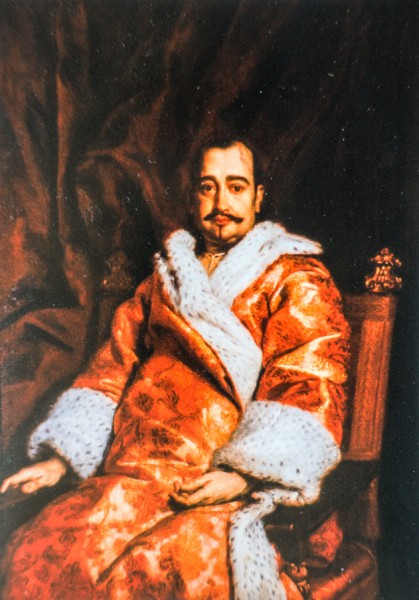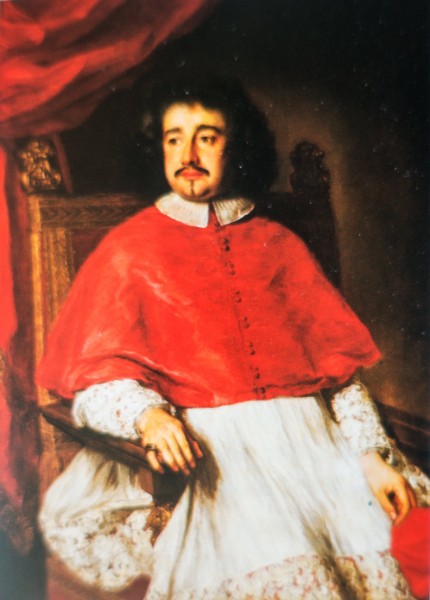
Palazzo Chigi-Odescalchi, Piazza dei Santi Apostoli, Giuseppe Vasi

Flavio Chigi cardinal in a bathrobe, Ferdinand Voet, private collection

Cardinal Flavio Chigi, Ferdinand Voet, Ariccia, Palazzo Chigi

Cardinal Flavio Chigi, Giovanni Maria Morandi, pic.Wikipedia

Basilica Santa Maria del Popolo, Chigi Chapel

Marble bust of Pope Alexander VII, Musei Vaticani
Although Flavio had been destined for the clergy since birth, this calling definitely went against his nature. Even in Cologne, at the court of his uncle, Cardinal Fabio Chigi, he tried his hand at being a clergyman, but apparently, he did not live up to expectations. He was sent back to Siena. He returned to Rome once again, when his uncle became Pope Alexander VII. As it would turn out, this controversial cardinal-nepot, who adored women, hunting, and art, became one of the main players at the following seven conclaves, after the death of his relative.
Although Flavio had been destined for the clergy since birth, this calling definitely went against his nature. Even in Cologne, at the court of his uncle, Cardinal Fabio Chigi, he tried his hand at being a clergyman, but apparently, he did not live up to expectations. He was sent back to Siena. He returned to Rome once again, when his uncle became Pope Alexander VII. As it would turn out, this controversial cardinal-nepot, who adored women, hunting, and art, became one of the main players at the following seven conclaves, after the death of his relative.
In 1655 Fabio Chigi was elected as pope. For one year he tried not to bring his family to Rome, claiming that as a Chigi he has relatives, but as pope – only the faithful. However, he quickly changed his mind and in the second year of his pontificate, made his nephew into a cardinal, which however carried with it several requirements. Flavio had to be ordained and had to remain under the watchful gaze of the Jesuits for a year. It was definitely worth it. The status of cardinal-nepot ensured him with important state posts (starting with being the head of foreign policy, and ending with healthcare ), as well as Church ones (he was the head of thirty different congregations), which provided him with not only prestige but also significant income. And money was something that Flavio, as a descendant of bankers, knew how to invest. He enthusiastically bought land and property in the Latium, purchasing it from other aristocrats, including the town of Ariccia, where he created his out-of-town residence.
Besides that, he was interested in cuisine, fashion, and hunting. In the sixties, he introduced luxurious French carriages onto Roman streets. He was also considered a true trendsetter in the field of clothing. His creations were widely commented, especially since he was thought to be a very attractive man.
In the Eternal City, he occupied the palace at Piazza Santi Apostoli (presently known as Palazzo Chigi-Odescalchi). The cardinal purchased it, had it restored while entrusting his decorations to Gian Lorenzo Bernini. The architect used this as an opportunity to create one of the most unique palace façades in all of Rome. However, that was not all. The interior of the residence, due to the splendor prevalent inside, enjoyed the opinion of being one of the greatest within the city. It housed (according to an inventory done in 1670), 839 paintings. The cardinal’s bedroom filled with mirrors and stuccos, where a magnificent bed was found, attracted special attention. It must be added that granting an audience while in bed, was not at that time considered extravagant. The cardinal was not a sickly man, however, any kind of detriment to his health was "treated" by remaining in bed, while receiving delegations of clients and guests created yet another occasion to demonstrate his prestige and exquisite taste, which in the case of Flavio had little to do with Christian motivation. The aforementioned bed was not only richly decorated with gilded columns and lined with satin, it also had – as was customary for those times – a baldachin. Its interior was decorated with a painting. What did it represent? No, it was neither heaven nor the glory of martyrs, which would seem a fitting image to fill the mind of the sleeping nepot. The scene was very pagan, if not to say highly erotic. In it, we will see the nude body of Endymion – a sheepherder, whom the gods punished with eternal sleep while maintaining his youthful beauty for eternity. The goddess Diana, seemingly oblivious to the fact that the youth is sleeping falls in love with him. However, the feeling is not mutual, since Endymion is not only in a deep slumber but has also lost all earthly desires. What conclusion can we draw from it? What was it that the painter Baciccio, the author of the painting and the painter's client, had wanted to tell us? The cardinal is dead and insensitive to earthly temptations. Well, as we know, his favorites included not only the well-known singer Angelica Voglia but also Maria Mancini – the wife of duke Colonna, which was viewed as a true scandal.
In turn, in Ariccia, the cardinal created an art gallery consisting of the images of 36 most beautiful Roman women. He also purchased and commissioned paintings that were very far removed from aspects of faith, while his favorite painter was the aforementioned Baciccio. On the other hand, the author of several portraits of Flavio himself, was the Flemish painter active in Rome at that time, Ferdinand Voet. One of these is worthy of special attention: it depicts the cardinal-nepot in a decisively private manner – in an elegant bathrobe.
While during the pontificate of Alexander VII, politics were of little interest to the cardinal, after the pope's death he exhibited great cunning and intelligence in the games played behind the scenes, gathering around himself cardinals who were chosen by his uncle, who constituted a strong group striving for papal nominations which would favor their interests.
As was fit for a member of the Chigi family, cardinal Flavio was buried in the family Chigi Chapel in the Basilica of Santa Maria del Popolo.
The aforementioned painting, which adorned the internal part of the cardinal’s baldachin, is presently located on the ceiling of the so-called Oval Room in the Chigi Palace, which today is the residence of the Prime Minister of the Republic of Italy.




















